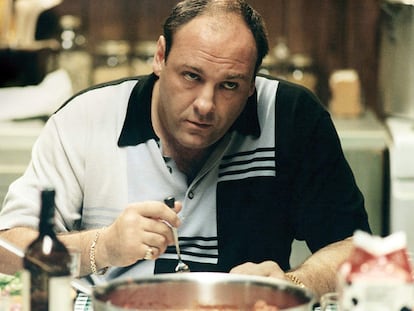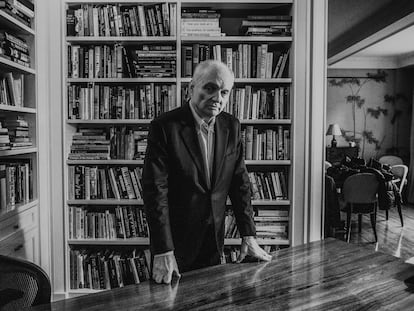Explicit violence, suggested sex: How Hollywood disguised homosexuality in gangster cinema
In a new work, film critic Juan Dos Ramos analyzes how the hypermasculinity of gangster cinema was the perfect terrain for men to love each other when that love was prohibited
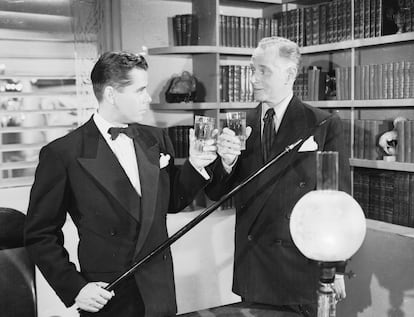
From the 1930s until the turn of the century, the gay character and the gangster are two figures who underwent an evolution in their cinematographic representation. Film has often doubled their marginality, in the figure of the gay gangster.
“Experts in film noir respond to a very canonical heterosexual profile. Whether out of reverence or mythologization, they haven’t been able to see — or haven’t wanted to see — the innumerable queer connotations that pulsate in the great classics,” explains Juan Dos Ramos, author of an essay (available only in Spanish) about gay gangsters in films: Gangsters maricas. Extravagancia y furia en el cine negro.
Below is a chronology of how this subgenre infiltrated films, with its most illustrative examples.

The gangster who understands, but understands nothing
In Little Caesar (1931) — directed by Marvin Leroy — Edward G. Robinson plays a small-time robber named Enrico “Little Caesar” Bandello, who moves to Chicago with his crony, who prefers to become a dancer in search of success. While his friend prospers and falls in love with another dancer, Little Caesar rises in the underworld and spends the entire film trying to get his former partner — the only person he trusts — to return to his side as the gang’s right-hand man. “Women don’t go well with business,” he warns him.
Near the end of the film, Little Caesar has his friend at gunpoint, but the bullets don’t come out. “The desperate look on his face at that moment says it all. It’s almost like a breakup scene: the gangster loses everything by exposing himself. That’s the great tragedy of [Enrico]: the man he loved has left him for a woman,” Dos Ramos explains. The protagonist — stricken by emotional turmoil — is ultimately gunned down by the police beneath a billboard advertising a performance by his friend and his friend’s lover.
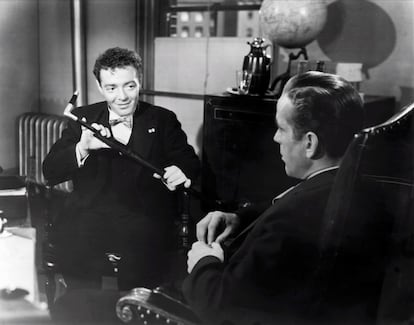
Humphrey Bogart: a macho man besieged by gay men
The editor of the novel The Maltese Falcon asked its author, Dashiell Hammett, to lessen the book’s gay undertones. When John Huston made it into a film in 1941, he took the clues left by the book to display a whole palette of dubious moralities, especially in the trio of blatantly gay gangsters who join Humphrey Bogart — who plays a detective with few ethical barriers — in the search for the prized falcon statuette.
Juan Dos Ramos points out: “Here, another of the rules of film noir is fulfilled: that of giving secondary characters [gay features] in order to solidify the manhood of the protagonist detective. It’s a technique that Raymond Chandler said was abundant among crime novel narrators.”
In the film, Peter Lorre composes one of the most brilliant roles of his career: that of Joel Cairo, a gangster who doesn’t hide his differences. He shows up at Bogart’s office, preceded by a card scented with his perfume. During the chat with the detective, he primly caresses his cane. The character of the fat gangster (Sydney Greenstreet) — always accompanied by his gunman friend, (Elisha Cook Jr.), whom he loves “like a son” — also doesn’t bother to hide his sexual preferences. When he decides to betray the young henchman, he comments: “If you lose a child, it’s always possible to get another one.”
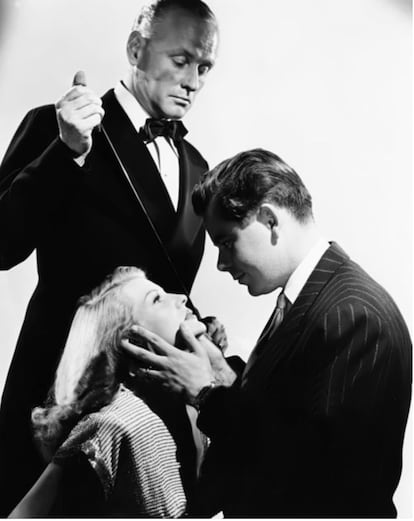
Gilda: the love triangle as an alibi
Gilda (1946) — directed by Charles Vidor — has gone down in history as a great precursor of coming out. Subtly, Rita Hayworth proposes a bisexual love triangle. All you have to do is look at the opening scene: Glenn Ford leaves an illegal gambling club in the port of Buenos Aires, after gambling with his fake dice. A criminal attempts to rob him, but is foiled by a blow from a cane, wielded by a mysterious dapper man — a gangster played by George Macready. From that moment onwards, the dialogue is filled with ambiguities and double-meanings.
“It is a most faithful and obedient friend: it is silent when I want it to be silent, but talks when I want to talk,” Macready says, referring to his cane. “That’s my idea of a friend.” Ford then responds that the cane’s life “must be very gay.” This was when the word was also used to imply that something was “happy” or “fun.” The two men celebrate their newfound friendship by smoking a cigarette and walking together through the port area. “A man who makes his own luck, as I do, recognizes in others,” the gangsters says, before saying goodbye to the man he rescued.
“They’re all signs for the queer eye,” Juan Dos Ramos clarifies. “They’re in the port — a cruising area par excellence — surrounded by criminals and sailors. The gangster appears on the scene raising his cane as a symbol of an erection. He soon offers this man, with whom he wants to flirt, a meteoric [rise] in the underworld. The love triangle dynamic is also a lot of fun. This gangster is aware that Glenn Ford is a heterosexual hottie and he brings Gilda on his arm as a [temptation], so that the three of them end up together. And so that there are no moral doubts, the villain dies skewered by his own staff: the penetrator is penetrated.”
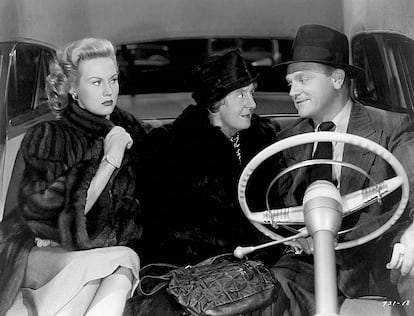
James Cagney and the Oedipus complex
For White Heat (1949), James Cagney wanted to play a sensitive thug, who cries and allows himself to be lulled to sleep by his mother (the matriarch of a criminal gang, eternally mourning for her husband). When she dies, the protagonist transfers his affections to a police officer who has infiltrated the gang.
The Spanish film critic notes: “The false criminal partner begins to take [his mom’s] place. He expects [this man to offer him] the protection and firmness that he found in his mother. It’s with him that he has the most intimate scenes: he wants to share his loot with him. [Simultaneously], he despises the woman who has been scripted for him (the explosive Virginia Mayo). After the major disappointment in love that involves the revelation of the agent’s true identity, of course, the gangster’s outcome is dramatic and violent, worthy of a madman… the only possible portrayal of a gay man in such prejudiced times. There’s an eagerness to dismantle a type of masculinity — I think Cagney was very aware of what he was doing,” Dos Ramos jokes.
If he’s gay, he must be depraved
From 1934 to 1967 the Hays Code — the censorship regulations promoted by Republican leader William H. Hays, to ensure morality on screen — forced directors and screenwriters to be bold. As Dos Ramos explains: “They used certain [signals], such as putting a flower in a big guy’s breast pocket, showing gentlemen going to the theater, putting on lots of perfume... We must also [mention] the use of narrative ellipses to resolve certain situations that suggest sexual encounters. The Hays Code also allowed for some relaxation if homosexuality was perceived as a brushstroke that underlined the monstrous nature of the gangster.”
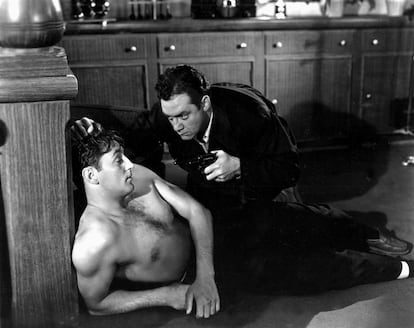
However, some productions revealed a particularly twisted catalog of sexual perversions. This is the case of Howard Hughes, the magnate and producer. The playboy never hid his bisexual voracity. For His Kind of Woman (1951) he cast two sex symbols: Jane Russell and Robert Mitchum. The queer gangster in this case is played by Raymond Burr, a strong, gay actor, who had created a false biography and who would later succeed in the series Perry Mason. In His Kind of Woman, Burr transforms into the alter ego of Howard Hughes, to unleash the most perverse fantasies of domination on the heterosexual male embodied by Mitchum. In the final scene — after the protagonist sneaks onto the bad guys’ ship — the villainous Burr delights in ordering his men to beat him up, strip him of his shirt, tie him to a mast, hit him with the buckle of a belt and finish the torture by locking him in a steam-filled engine room, which makes Mitchum sweat as if he were in a sauna. A veritable bondage party, only tolerated because the good guy wins and gets the girl in the end.
And finally, he came out of the closet
Probably the pioneering film about the openly gay gangster is The Big Heat (1953), directed by Fritz Lang. The opening sequence presents the mature Alexander Scourby, wrapped in silk pijamas, in bed with a handsome and attentive young man, who dials his phone calls and lights his cigarettes. Later, we’ll discover that Scourby has a daughter, but there’s no sign of a wife. “The relaxation of the Hays Code made it possible to [address] the demands [and curiosities] of a public in search of stories that reflected more realistic situations,” Dos Ramos analyzes.
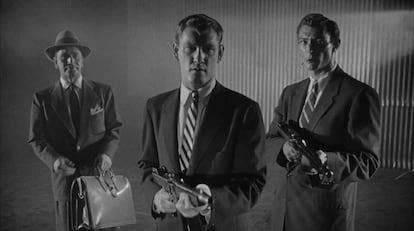
In this context, for example, the ruthless pair of gay gunmen in The Big Combo (1955) came about. Perhaps this was possible because it was a B movie, allowed to take greater risks. “I can’t eat more salami,” one of the men complais. “That’s all there is,” the other responds. “The cops will be looking for us in every closet!” Mingo panics, before they both meet a tragic end.
However, the first film that would finally offer up an openly queer crime lord was British: Villain (1971). This movie was also a turning point because it featured — for the first time — a superstar in a queer role: Richard Burton. In it, we see Burton and his lover — Ian McShane — enter and leave the bedroom while wearing bath robes (although the kiss that was filmed ended up being taken out in the final cut). Despite this, the film critic emphasizes that “it’s a work that retains its appeal. Furthermore, it added a layer to the [noir] genre that only European tradition could give it. American film noir is more prefabricated in its esthetics, [while in British noir], the dandyism of Oscar Wilde appears. Gangster clothing is essential; the British cultivate that very well.”
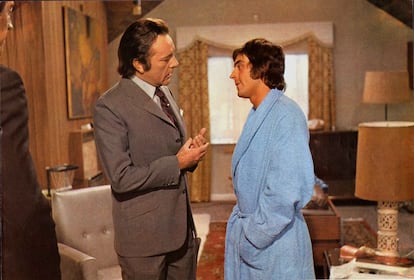
Burton’s character is based on one of the Kray twins, famous real figures of English organized crime. Impeccably groomed, tough-looking and openly gay, Ron Kray became a pop culture icon. So much so that we’ve even seen everything from a biopic — The Krays (1990) — to an interpretive pirouette by Tom Hardy playing both twins simultaneously in Legend (2015). Which brings us to the next point: the inevitable meeting between the figure of the gangster and that of the music star.
The “glitter” gangster
The evolution of the so-called “glitter gangster” was given to us by Performance (1970), starring Donald Cammell and Nicolas Roeg. James Fox — an aggressive gangster hiding from his own mob — and a rocker in the middle of a creative block (Mick Jagger) get together. In the middle of this trip (literally, in the middle of a trip on hallucinogenic mushrooms), Anita Pallenberg (the then-girlfriend of another Rolling Stone, Keith Richards) tells the thug — who is camouflaged under makeup and a wig — that her musician lover is “a male and female man” whose “demand has abandoned him.”
We also see the criminal sleep with an androgynous groupie, murmuring in the middle of the act: “you look like a little boy.” The imaginary performance of Jagger dressed up as a gangster — with the ambiguous and plump members of the underworld rioting around him — is so outrageous that one can only applaud this film’s existence.
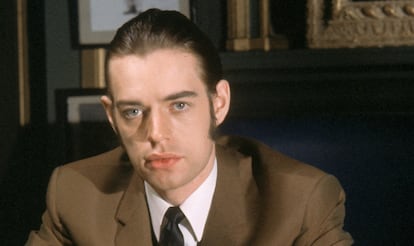
To all this, we must add the openly gay nature of the boss who pursues the protagonist: a bald, hairy, average-looking guy, who we see entertaining hustlers and flipping through bodybuilder magazines, surrounded by his gang of weirdos. In the words of Dos Ramos, it’s “a miracle of a movie. Not only for equating the figure of the pop star with the American gangster — something that made headlines in the golden age — but also for developing all those new masculinities that sexual liberation [and psychedelic drugs] brought about in the late-1960s.”
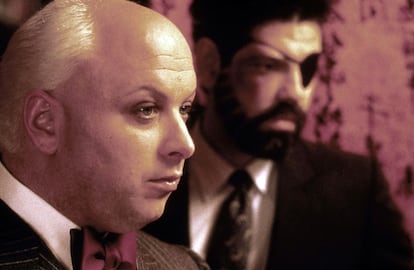
If we’re talking about transcending identities and genders, we cannot ignore the first (and almost only) male role played by the drag queen Divine, the muse of John Waters: the egomaniacal, authoritarian and misogynistic gangster from the film Trouble in Mind (1985). Despite her few appearances, she stands out as the undeniable hook of the film, composing what Juan Dos Ramos calls “a postmodern gangster, beyond all clichés.”
David Lynch twists everything
The terms “gay” or “queer gangster” are never black or white. Rather, they occupy a wide-rage of grays. But nobody has the palette of very dark tones that David Lynch uses in his scripts and movies. In two of his masterpieces — Blue Velvet (1986) and Lost Highway (1997) — he confronts us with villains of unorthodox sexuality, extravagant and terrifying. In the words of Dos Ramos, “this probably responds to Lynch’s devotion to classic film noir. When you grow up seeing these types of more ambiguous characters always presented as depraved and with a tortured inner-life, you don’t separate the criminal part from sexual orientation. I imagine David Lynch watching those films as a young man and sensing that not only are [gangsters] evil, but they have a dark, almost indescribable sexuality — something that he appropriates and enhances. The portrait he paints in these two films may even be homophobic, but it serves to make his characters even more sinister, [as he] searches for a brutal esthetic impact.”
Let’s think of Dean Stockwell’s character in Blue Velvet: a sinister crooner who is heavily made up, with a smoking cigarette holder and frilly shirt. He establishes an electrifying connection with the twisted Dennis Hopper. They share drugs and lewd glances, while extorting money from the femme fatale (Isabella Rossellini) under the gaze of antihero Kyle MacLachlan.
Hopper eventually abducts a young couple, exclaiming, “Let’s fuck! I’ll fuck anything that moves!” From there, he subjects them to a drug trip at the end of the night in which — after taking some poppers — he attempts to sexually assault Dorothy (Rossellini) and beats her husband Greg. He does all this with lipstick smeared all over his face.
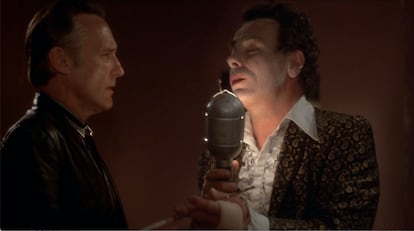
In Lost Highway, the gangster, played by Robert Loggia, doesn’t appear as outrageous, but he’s equally disturbing. After forcing his trusted young mechanic (Balthazar Getty) to get into his car, he tests his chances by inviting him to watch a pornographic movie. In an allusion to Gilda (a film that Lynch is a big fan of), he then tries to capture the young man by introducing him to a beautiful blonde, Patricia Arquette. “Loggia introduces Arquette in the same way the casino gangster introduces Rita Hayworth: he first probes the boy, but sees that he’s not going to get anything. And, one day, he appears with the stunning girl at his side [to lure him].” Times change, but depraved impulses remain.
If you’re a man, you’ll like it
Quentin Tarantino has said it many times: “Gay subtext always makes a movie better.” In Reservoir Dogs (1992) he materialized this in the form of the romantic background that unites Mr. White (Harvey Keitel) and Mr. Orange (Tim Roth). After everything in the robbery has gone wrong, White spends practically half of the film cradling a dying Orange in a pool of blood, in the hope that perhaps the crony whom he has grown attached to will survive being shot. They’re an example of what Juan Dos Ramos has termed “super love. We’re not talking about a gay nature in its literal sense, but rather about the bonds generated by men who live in hypermasculine environments, in constant danger, always afraid of not knowing who to trust. They face such critical situations together that they develop other emotional dynamics in which women have very little weight,” the critic notes.
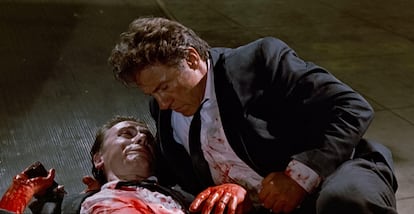
This theme is also manifested in Lock & Stock (1998), where everything plays in favor of an overflowing and testosterone-filled camaraderie. Gay jokes abound, while women are made conspicuous by their absence. “[The characters are] guys who get horny with each other while they have [guy talk]. It’s almost like a dirty gay sex movie,” Dos Ramos explains, “filmed in some unsanitary basement in East London, with the explicit scenes cut out.”
The Sopranos: homosexuality is not forgiven
In the iconic HBO series The Sopranos, the sad end of Vito Spatafore — one of Tony Soprano’s most loyal gangsters — reveals the Italian-American mob’s complexes in the face of any alternative that challenges traditional masculinity. This subplot is based on the real case of John D’Amato, better known as “Johnny Boy,” boss of the DeCavalcante family, the most powerful in New Jersey. His wife revealed that they went to swingers clubs together and that her husband had a particular propensity to give himself to other men in those settings. He was shot to death by soldiers from his own ranks in 1992 as a result of this. In the investigation of his death, an informant slipped that “no one is going to respect us if we have a [gay] boss discussing [issues related to] La Cosa Nostra.”

In the series, Vito goes from respectable construction boss to being disowned, when he’s discovered in a gay nightclub, dancing in chaps. He quickly flees Jersey for New England, where he has a fleeting affair with a gay firefighter who has a wife and kids. However, as he struggles to adjust to an ordinary life, he begs Tony Soprano (James Gandolfini) for mercy, claiming that he was engaging in gay activities because of “his back medication.” While Tony agrees to let him come back (in exchange for $200,000), his captains and soldiers are appalled. And, despite Tony’s greed, the mafia doesn’t forgive so easily.
Vito is eventually beaten to death in a hotel, with a pool cue stuck up his rectum. He was killed by his wife’s cousin and mobsters from another family. “The choice of such a graphic and beastly ending responds to the scriptwriters’ need to reinforce that monolithic and traditional thinking of the Italian-American man, an inheritance of attitudes from the old Sicilian mafias, where probably only violating the omertà (the law of silence) is a greater sin than being gay,” Dos Ramos affirms.
Goodbye gay gangster?
The gangster model (gay or not) became obsolete at the turn of the century. In the era of hypertechnification and advanced dystopias, his figure could take any form, from a villainous algorithm that steals and extorts people using AI, to the incarnation of an Elon Musk-type megalomaniac, kingpin of the stratospheres. Or, more vulgarly, that of bankers, politicians and owners of sports teams. In any case, with the taboo of homosexuality practically dismantled on screen, the concept of a queer gangster no longer has a clear meaning for the future.
The author of the book concludes: “Sexuality ends up being irrelevant when you have power. Another thing is to explore queerness in this new scenario, in which the patriarchal system has collapsed, new models of masculinity proliferate in the media and LGBTQ+ achievements have drawn a new framework [for storytelling]. In this new reality, the gay gangster is no longer going to be something so rare or so sophisticated. Likewise, the modern heterosexual man has appropriated behaviors and actions that were previously unthinkable, because they were considered feminine. So, if we say goodbye to the macho man, we can also say goodbye to the gay gangster.”
Sign up for our weekly newsletter to get more English-language news coverage from EL PAÍS USA Edition
Tu suscripción se está usando en otro dispositivo
¿Quieres añadir otro usuario a tu suscripción?
Si continúas leyendo en este dispositivo, no se podrá leer en el otro.
FlechaTu suscripción se está usando en otro dispositivo y solo puedes acceder a EL PAÍS desde un dispositivo a la vez.
Si quieres compartir tu cuenta, cambia tu suscripción a la modalidad Premium, así podrás añadir otro usuario. Cada uno accederá con su propia cuenta de email, lo que os permitirá personalizar vuestra experiencia en EL PAÍS.
¿Tienes una suscripción de empresa? Accede aquí para contratar más cuentas.
En el caso de no saber quién está usando tu cuenta, te recomendamos cambiar tu contraseña aquí.
Si decides continuar compartiendo tu cuenta, este mensaje se mostrará en tu dispositivo y en el de la otra persona que está usando tu cuenta de forma indefinida, afectando a tu experiencia de lectura. Puedes consultar aquí los términos y condiciones de la suscripción digital.
More information
Archived In
Últimas noticias
Most viewed
- Alain Aspect, Nobel laureate in physics: ‘Einstein was so smart that he would have had to recognize quantum entanglement’
- The US bombing of Venezuela, in pictures
- Oil, gold and rare earth elements: the backdrop to US political tension with Venezuela
- Maps of the US attack on Venezuela: Targets, airspace and deployed fleet
- Delta Force, the elite US military unit that captured Maduro
